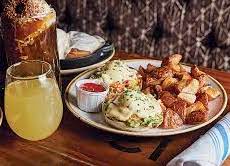Brunch, America’s Favorite Weekend Meal

As we approach Mother’s Day, restaurants, hotels, and other eateries throughout the nation will be promoting special brunch menus in an attempt to maximize sales on this, perhaps the busiest day in the hospitality business. But make no mistake, brunches are not reserved just for Mother’s Day and Easter, or even birthdays and baby showers. Today the weekend brunch is quickly becoming everyone’s favorite meal.
But have you ever wondered about the origin of this popular meal?
Where Brunch Came From
The term “brunch” is a made-up word, a portmanteau if you will, coined from the words “breakfast” and “lunch.” It is thought to have been created in 1895 by British author Guy Beringer in his Hunter’s Weekly article titled “Brunch: A Plea." The article suggested that  instead of their ritualistic early Sunday post-church dinners consisting of heavy meats and savory pies, Brit’s would be happier partaking of a noon-day brunch that starts with tea or coffee, marmalade, and other breakfast fare, then graduates to a fish dish and one or two meat courses.
instead of their ritualistic early Sunday post-church dinners consisting of heavy meats and savory pies, Brit’s would be happier partaking of a noon-day brunch that starts with tea or coffee, marmalade, and other breakfast fare, then graduates to a fish dish and one or two meat courses.
The article went on to explain the authors reasoning for his new meal:
By eliminating the need to get up early on Sunday, brunch would make life brighter for Saturday-night carousers. It would promote human happiness in other ways as well.
“Brunch is cheerful, sociable and inciting. It is talk-compelling. It puts you in a good temper, it makes you satisfied with yourself and your fellow beings, it sweeps away the worries and cobwebs of the week.”
In closing his article, Beringer suggested that beer and whiskey could be substituted for tea and coffee if one chooses, thus paving the way for today’s Mimosas, Bloody Marys and Fresh 75s.
Brunch comes to America
 In America Beringer’s new word first appeared in an essay published in the “New and Notes for Women” column of the 1896 edition of New Oxford News. The piece entitled “The Newest Thing in Lunches,” introduced readers to the latest “fad” of a sumptuous Sunday nosh served at 11 o’clock a.m.
In America Beringer’s new word first appeared in an essay published in the “New and Notes for Women” column of the 1896 edition of New Oxford News. The piece entitled “The Newest Thing in Lunches,” introduced readers to the latest “fad” of a sumptuous Sunday nosh served at 11 o’clock a.m.
At first, Sunday brunch was considered a luxury meal and was served only in the fanciest hotels, to their elite clientele. Lavish dishes such as oysters, caviar, and eggs Benedict were the norm. Of course it didn’t help brunch’s popularity that at the time New York restaurants were prohibited, by law, to open on Sunday’s. It would take another decade and World War II for brunch to catch on with America’s middle class.
 By the 1930s, brunch was becoming chic as word spread that movie stars and other celebrities riding transcontinental trains between New York and Los Angeles would stop in Chicago to enjoy a late morning meal at one of the hotel buffets. According to a New York Times article, especially popular was the famous Pump Room of Chicago’s Ambassador Hotel. By 1939 Sunday brunch had become so popular with the masses that it was declared a two-meal day
By the 1930s, brunch was becoming chic as word spread that movie stars and other celebrities riding transcontinental trains between New York and Los Angeles would stop in Chicago to enjoy a late morning meal at one of the hotel buffets. According to a New York Times article, especially popular was the famous Pump Room of Chicago’s Ambassador Hotel. By 1939 Sunday brunch had become so popular with the masses that it was declared a two-meal day
By the 1990s Sunday brunch had become so well received in this country that it was extended to Saturday as well. And while today brunch is Americas most popular weekend meal, its favored much more in some areas than others. For example, brunch’s popularity is more concentrated on the United States’ coastal cities than those in the Midwestern and Western states. Exceptions to that trend are the large cities in Illinois and Pennsylvania.
 In spite of the fact that statistics show brunching to be more concentrated on the coasts, interest is continuing to spread at a phenomenal rate. More and more restaurants and casual eateries are beginning to offer weekend brunch. Even some fast-food chains have began exploring how adding brunch items to their menus will impact customer satisfaction.
In spite of the fact that statistics show brunching to be more concentrated on the coasts, interest is continuing to spread at a phenomenal rate. More and more restaurants and casual eateries are beginning to offer weekend brunch. Even some fast-food chains have began exploring how adding brunch items to their menus will impact customer satisfaction.


